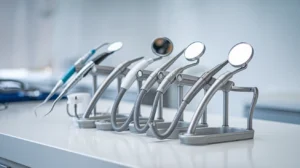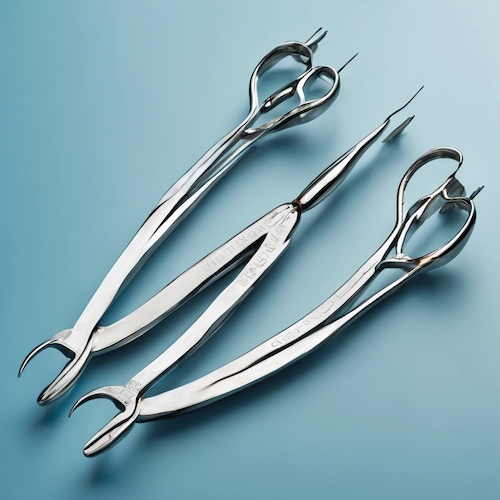
How to Choose the Best Dental Mouth Mirror for Oral Care
Picking the right dental mouth mirror might seem like a small task, but it’s actually pretty important for keeping your teeth and gums healthy. With so many options out there,

The success of dental extractions depends heavily on our tools, and dental forceps are the most crucial instruments we use. These forceps’ material quality can determine whether the procedure goes smoothly or becomes challenging.
Dental forceps materials have evolved dramatically over the last several years. Traditional stainless steel forceps have given way to modern titanium versions. Each material offers unique benefits that affect our daily practice.
This detailed piece compares different dental forceps materials to help you pick the right ones. We’ll look at their durability, precision, and affordable options. You’ll also learn about sterilization needs to match your practice’s requirements.
The composition of dental forceps materials goes far beyond basic instrument makeup. Material selection directly affects both practitioner efficiency and patient experience. Studies reveal that almost 90% of dental professionals prioritize clinical research in selecting materials for their practice.
Our daily practice shows how proper material choices can substantially extend instrument life. Instruments made from subpar materials wear out faster and might fail during procedures. This reality touches both durability and consistent performance throughout the instrument’s service life.
These key factors make material selection vital:
Material choice plays a crucial role in practitioner health, according to recent ergonomic design studies. Research shows that instruments designed with user adaptability and appropriate materials can substantially decrease the incidence of musculoskeletal disorders in dental professionals.
The rise of dental materials has created new possibilities for instrument design and functionality. More than half of practitioners try new materials monthly, showing a growing focus on evidence-based material selection. This trend showcases our profession’s steadfast dedication to blending traditional reliability with modern breakthroughs.
Tooth extraction requires complex movements like gripping, twisting, and traction. This makes material quality even more critical. Quality materials ensure forceps to withstand these forces while maintaining precision and control throughout the procedure.
Our dental practice has observed several key materials that dominate the forceps manufacturing world. Modern dentistry offers various options worth exploring.
Stainless steel leads the dental forceps manufacturing field, yet quality varies significantly. Many manufacturers use American-made stainless steel. German or French stainless steel alternatives are nowhere near similar and provide better durability. 420 surgical French stainless steel stands at the top of forceps materials and delivers unmatched durability with precision.
The most common dental forceps materials include:

Carbon alloy forceps in cheaper instruments contain low chromium content. These tools tend to dull quickly despite their original strength. Tungsten carbide-tipped instruments provide a stronger grip and last longer.
Carbon-free metal represents an exciting development that performs up to four times longer than traditional stainless steel counterparts. These innovative materials show how far dental technology has advanced beyond simple steel instruments.
Surgical-grade 420 German or French stainless steel remains the gold standard to achieve premium quality. These materials’ structural integrity lasts longer and delivers the precision needed for complex extractions. High-grade materials ensure consistent performance through numerous procedures when properly managed.
Let’s head over to a detailed comparison of dental forceps materials that draws from our clinical experience and recent research. Our findings show that high-quality stainless steel stands out as the top choice because of its strength and resistance to corrosion.
Different materials perform distinctly across key factors:
Durability and Maintenance:
Our observations reveal how different materials resist corrosion. Several factors can affect corrosion rates by a lot:
Modern manufacturing methods bring exciting changes to the field. New breakthroughs in CAD/CAM technologies have brought CNC milling and 3D printing into the picture, which changes how dental forceps are made today.
High-quality stainless steel forceps keep working well even after many rounds of autoclaving. This makes them a great long-term investment that delivers consistent results throughout their life.
New specialized materials have caught everyone’s attention. To name just one example, modern dental alloys made through selective laser melting (SLM) and direct metal laser sintering (DMLS) show great promise in durability and precision. These advanced manufacturing techniques work great for practices that want to invest in tools that last long and perform well.

Your dental practice’s efficiency and success depend on choosing the right material for your forceps. Our experience shows that smart material choices can substantially improve both instrument life and performance during procedures.
These are the vital considerations for dental forceps materials:
Quality materials are worth the investment. American-made stainless steel options work well, but German or French stainless steel alternatives have proven more durable. This difference becomes obvious during complex procedures that demand reliable instruments.
Sterilization compatibility should be a top priority. Our research shows that instruments incompatible with sterilization protocols might deteriorate faster, which leads to higher replacement costs. This becomes even more important for busy practices that need frequent sterilization cycles.
Surgical-grade 420 stainless steel from trusted European manufacturers stands out as the best choice. This material delivers both precision during procedures and durability for extended use. The upfront cost of quality materials pays off through fewer replacements and better reliability during procedures.
Dental forceps materials are changing rapidly with new technology and evolving clinical requirements. Choosing the right material means weighing several important factors based on your specific needs.
Our hands-on work with dental forceps has revealed crucial insights about their real-world use. Premium materials like surgical-grade 420 stainless steel forceps cost more upfront but prove their worth through longer life spans and consistent performance.
The future looks promising for dental forceps materials, with breakthroughs expected in these key areas:
Creating the perfect dental forceps requires balancing durability, precision, and comfort for practitioners. Your choice between classic stainless steel or modern titanium dental forceps will affect your practice’s efficiency and patient results significantly.
Dental professionals should keep up with material advances and assess their instrument choices regularly. The right dental forceps material goes beyond meeting current needs – it’s an investment in your practice’s long-term success.
The main materials used for dental forceps include stainless steel (with German and French variants being superior), carbon alloy, tungsten carbide, and titanium. Each material offers different levels of durability, precision, and cost-effectiveness, with high-grade stainless steel generally providing the best balance of qualities.
The material of dental forceps directly impacts procedural safety, cost efficiency, patient comfort, and professional reliability. Higher-quality materials reduce the risk of instrument failure, extend the lifespan of the forceps, ensure smoother procedures, and maintain consistent performance over time.
Yes, there are innovative materials being developed for dental forceps. These include carbon-free metal, which can perform up to four times longer than traditional stainless steel, and specialized alloys processed through advanced manufacturing techniques like selective laser melting (SLM) and direct metal laser sintering (DMLS).
Sterilization compatibility is crucial when selecting dental forceps. High-quality materials like surgical-grade stainless steel can maintain their integrity even after repeated autoclaving cycles. It’s essential to choose forceps that can withstand your specific sterilization protocols to ensure long-term value and consistent performance.
When choosing forceps materials, dentists should consider material quality (with a preference for surgical-grade 420 German or French stainless steel), sterilization compatibility, long-term value, and performance reliability. Investing in high-quality materials often results in better return on investment due to extended instrument lifespan and reduced risk of failure during procedures.

Picking the right dental mouth mirror might seem like a small task, but it’s actually pretty important for keeping your teeth and gums healthy. With so many options out there,

Dental mirrors have come a long way. From simple reflective tools to sophisticated gadgets, they play a key role in modern dentistry. With constant innovation in dental mirrors, these aren’t

Hey there, dental pros! Today, we’re diving into something super important but often overlooked—how to properly mouth mirror sterilization. If you’re in the dental field, you know these little tools
At The Surgical Kit, we are committed to providing healthcare professionals with the finest tools to ensure precision and safety in every procedure.